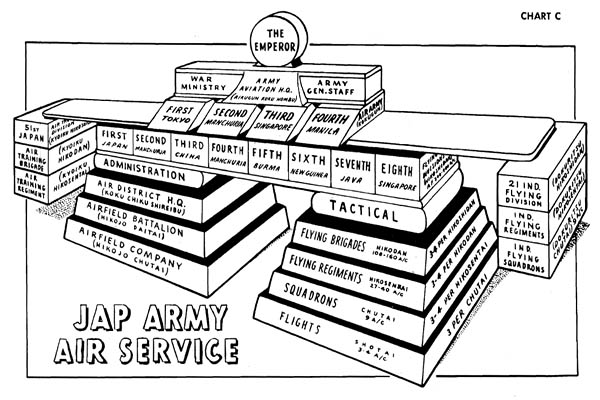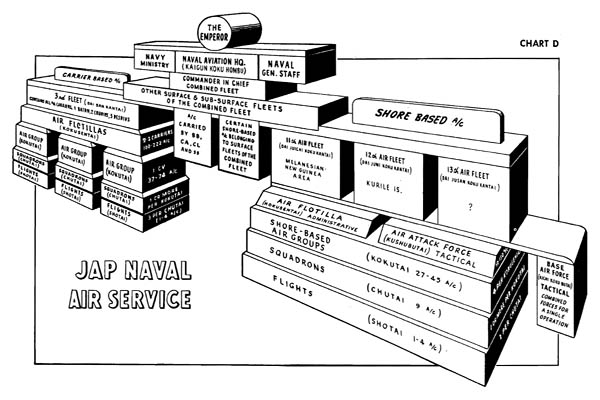Organization of the WWII Japanese Army Air Service and Naval Air Service from the U.S. War Department’s Handbook for Combat Air Intelligence Officers, Army Air Forces Air Intelligence School, Harrisburg, Pennsylvania, March 1944.
3. ORGANIZATION.
a. General.
(1) Owing to the excellence of Japanese counterintelligence during the years in which they were building their air strength, and owing to the difficulty of the Japanese language, Allied information about the organization of the Japanese Air Services is scanty and possibly inaccurate. (Charts C and D give the latest information available about the organization of both the Army and Naval Air Services.)
b. The Army Air Service.
(1) Army Aviation Headquarters controls and administers all Army air operations and training.
(2) Army air force units, which are staffs rather than commands, are organized into four Air Armies (Kokugun), each permanently located and each exercising strategic control within its geographical area.
(3) The largest technical and administrative organization is the Flying Division (Hikoshidan), of which there are eight. These units are assigned geographical areas and exercise operational and administrative control over all flying and ground organizations in the area. They are of no fixed size or composition and subordinate units may be freely shifted from one Hikoshidan to another. Each Hikoshidan is commanded by a Lt. General or a Major General.
(4) The Flying Brigade (Hikodan) has tactical responsibilities only. It is highly mobile and is often shifted from one division to another.
(5) Within the Flying Brigades are the Flying Regiments (Hikosentai), the largest units normally composed of only one type of aircraft. These purely tactical units are commanded by a Lt. Col. or Major.
(6) Each Flying Regiment is composed of three squadrons (Chutai), commanded by a captain. When in flight, the three squadrons are termed a Daitai and the formation compares to an AAF Combat Wing.
(7) Each squadron is divided into three flights (Shotai), of three aircraft each. The Shotai, like the AAF Flight, exists as a unit only in air fOmation.
(8) Primary and intermediate training in the Army Air Services is controlled by an Air Training Division (Kyoiku Hikoshidan), which is made of Air Training Brigades, (Kyoiku Hikodan) and Air Training Regiments, (Kyoiku Hikosentai).
(9) For reconnaissance, army cooperation, anti-submarine patrols and meteorological flights, there are Independent Flying Divisions (Dokuritsu Hikoshidan), Independent Flying Regiments (Dokuritsu Hikosentai), and Independent Flying Squadrons (Dokuritsu Hikochutai).
c. The Naval Air Service.
(1) Except for certain aircraft carried by surface vessels, all Naval aircraft are parts of the Third, Eleventh, Twelfth and Thirteenth Air Fleets. All shipborne aircraft are in the Third, land-based aircraft are in the Eleventh, Twelfth and Thirteenth. Each of these fleets is commanded by a Vice-Admiral.
(2) The Third Air Fleet is divided into Air Flotillas (Kokusentai), each commanded by a Rear Admiral and each composed of 2-3 carriers with an aircraft complement of 100-222 aircraft. The Flotillas are composed of Air Groups (Kokutai), each comprising the air complement of one carrier.
(3) The Eleventh, Twelfth and Thirteenth Air Fleets are divided administratively into Air Flotillas (Kokusentai) and tactically into Air Attack Forces (Kushubutai) of land-based naval aircraft.
(4) Naval Air Training. The Combined Naval Air Corps (Kaigun Rengo Koku Sotai), located in Japan, has the responsibility for training.











